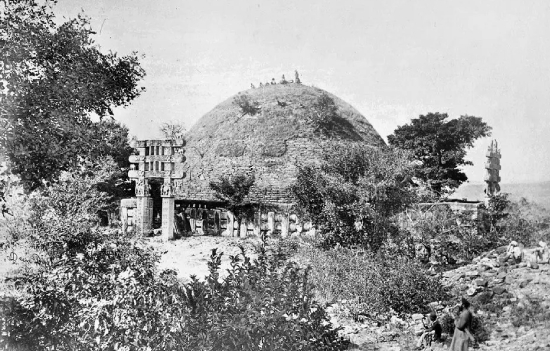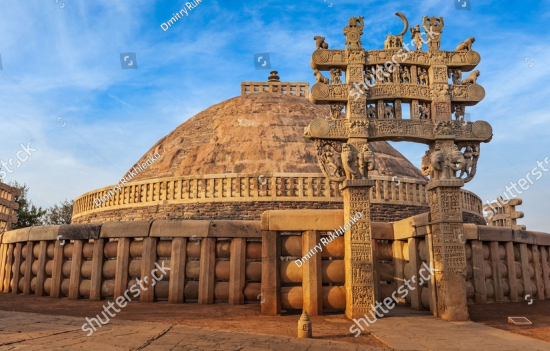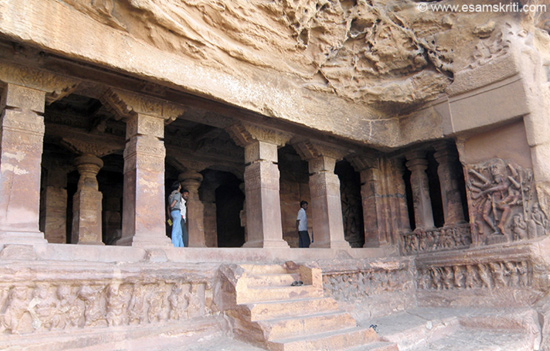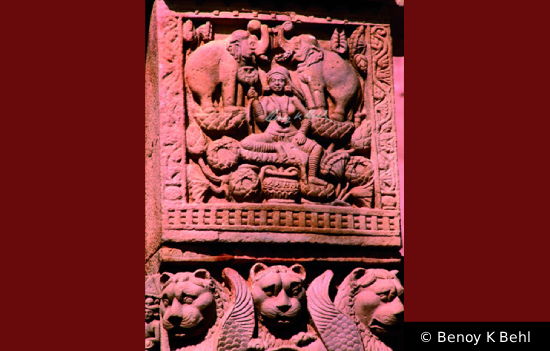- What is a Stupa? Why was the Great
Stupa made at Sanchi? Biggest contributors to the Stupa were Hindu rulers-Sungas
and Satavahana. What is the importance of Vidisha
i.e. kms away from Sanchi?
What is a Stupa?
 Stupa at made in honour of Sujata, daughter of a village chief, who gave Buddha milk-rice because Buddha had gone weak after meditating at Pragbodhi Caves.
Stupa at made in honour of Sujata, daughter of a village chief, who gave Buddha milk-rice because Buddha had gone weak after meditating at Pragbodhi Caves.
See pics 10 to 12 of this album for Sujata
Stupa and Temple at Bodh Gaya.
Stupa means heap in a dome-like
form erected over the mortal remains of Buddha and Buddhist saints. The
practice of erecting mounds over the body remains of the dead goes back to
pre-historic times. Cultural Heritage of
India Volume 1 published by the Ramakrishna Mission Institute of Culture,
Pg 37
“Ananda (key devotee of Buddha) erected a stupa over the remains of Buddha body, after it was burnt on the funeral pyre. In course of time, stupa acquired a special Buddhist association as containing a relic (dhatu) of the master or his chief disciples, as marking a spot associated with some imp event in the life of Buddha or in the history of Buddhism.” 3 Pg 487
“Before introduction of images, the stupa, as enshrining the relics of the master, was the centre and focus of the devotion and adoration for Buddhists. 3 Pg 494
“Stupas having the character of sacred monuments are known as the chaityas, and chaitya hall is the shrine in which the votive chaitya occupied the place of the altar.” 3
Why was the Great Stupa made at Sanchi?
Eight reasons of which four are from MP Tourism
site –
1. The interest of the great Mauryan emperor
Ashoka in Vidisha and around was because his wife Devi (Vedisha-Mahadevi) belonged
to Vidisha. Also 2 Pg. 9 He was deputed to Ujjain at Viceroy because of the region’s prosperity and consequently revenue potential.
2. “Vidisha near Sanchi is an antique town that has played a significant role not only in Ramayana and Meghdoot but also during the golden era of Mauryas and Guptas. Put together in the fork of the Betwa and Bes rivers, Vidisha district is an embodiment of numerous historical treasures. Just a few kilometres from the city are the ancient, Udaygiri Caves and Gyaraspur.” MP Tourism site Also 2 Pg. 10
3. “Ashoka’s wife practiced Buddhism and was also the reason behind the construction of the great Sanchi Stupa. Apart from having many Buddhist monasteries nearby, Vijaymandir (Bijamandal) of the 11th century is a unique addition to the temples of Vidisha, converted into a mosque in 1682. On the outskirts of Vidisha, is the Heliodorus Pillar dedicated to Vishnu. Today, pillar is worshipped by the locals as Khamba Baba.” MP Tourism site Local sources
state this was once a huge temple there.
 Board at Sanchi by
ASI. Pic courtesy Guide Rakesh.
Board at Sanchi by
ASI. Pic courtesy Guide Rakesh.
4. Noted art historian and photographer Benoy K Behl wrote, “The city of Vidisha, present-day Besnagar in Madhya Pradesh, was on the trade route which connected the plains of the Ganga to the Western Coast. It was also a great market place, at the centre of the vast and fertile plains of Central India. Among the earliest objects to be found here is a large stone pillar with an inscription, dated between 120–100 BCE. It was set up by a Greek devotee named Heliodorus, in honour of Vasudeva, another name of Lord Vishnu.”
“The ancient town of Besnagar lies 3 kms from present-day Vidisha, on the west side of the river.” 7 Vidisha is about 250 kms from the important city of
Ujjain.
5. In addition, Sanchi hilltop was an ideal place for the establishment of a monastery having a suitable atmosphere for meditation/other spiritual activities.” Also 2 Pg. 10
Hindu and Buddhist pilgrimage places were
usually close to each other like Gaya and Bodh Gaya or Vidisha and Sanchi or at
the same location like Ellora, Aihole, Badami. Since devotees visit one place,
naturally they are also likely to visit the other. Sanchi is only about nine kms
from Vidisha.
Read Coexistence of Hindu, Buddhist and Jain monuments and pilgrimages
6. “There was also an important school of art in Vidisha, which according to some scholars, was the capital of the later Sunga kings. They were responsible for the fine gateway railing which surround the Sanchi stupas built by Ashoka. 3 Pg 99
“Panini traces the Sungas to the Brahmana clan of Bharadvaja.” 3 Pg
95
7.
There was something special about Sanchi and areas around it. Archaeological
excavations have shown there were app 145 settlements in and around the complex
that are just 11 kms from Besnagar/Vidhisha. According to Rediscovering Sanchi in Peepultree, “The stupas of Sonari, Satdhara, Morel Khurd and Andher, all in a radius of 15 km from Sanchi,” deserve more attention.
8. According to a
local scholar, Sanchi/adjoining areas were part of Tantra tradition. Several
stupas and Temples are there to tale the tale. He believes that the ASI needs
to do a lot of excavation to find more proof of the existence of Tantra. Two
simple symbols.
There is a standing Nandi at the Sandipani Ashram in Ujjain. A standing Nandi is a strong symbol of Tantra. Two, in Gyaraspur town close to Vidisha is a Maladevi Mandir. While it is a Jain Temple today, there is an image of Goddess Chakreshvari carved on the lalata-bimba of the temple. “However, the Lalata Bimba that is the most accurate insignia of a temple has a carving of Vaishnav Devi seated on Garuda establishing without a shadow of doubt that the original structure was a Devi temple.” Source and 9 Local sources say the Goddess was the
Kula Devata of the then ruler.
 Standing Nandi found very rarely. This is at Sandipani Ashram, Ujjain.
Standing Nandi found very rarely. This is at Sandipani Ashram, Ujjain.
Another Nandi in standing position exists at
the Chausath Yogini Mandir i.e. near Jabalpur, Madhya Pradesh. To see album
 Stupa 1 in 1875. Courtesy Wikipedia Commons.
Stupa 1 in 1875. Courtesy Wikipedia Commons. Current picture of Stupa 1 with 3 of the 4 Gateways
Current picture of Stupa 1 with 3 of the 4 Gateways Simply, Ashoka built Stupa 1 or Great Stupa that was
enlarged by Sungas (Hindus-185
BC-73 AD). Gateway built in first century BC by Satvahanas (Hindus). During Gupta
period, several temples were built/sculptures added. Construction continued up
to 12th century. 2 (ASI
booklet on Sanchi) Read on.
“The foundation of Sanchi site was probably laid by Ashoka, when he built a stupa and erected a monolithic pillar here.” 2 Pg. 9
“The Great Stupa 1 at Sanchi originally built by Asoka time, was enlarged to twice its size and enveloped in stone, perhaps a century later, when the stone railings and gateways were added.” 3
Pg 488
The reign of the Sungas saw enlargement of the stupa of Asoka, erection of balustrades around its ground, berm, stairway and harmika, reconstruction of Temple 40 and building of Stupas 2&3.” 2 Pg. 11
According to Rediscovering Sanchi in Peepultree, “His son Agnimitra (r. 149 – 141 BCE), who was Governor of the region, based in Vidisha, rebuilt much of the stupa, adding the outer structure or casing of the Great Stupa and the railings. It was during this period that Stupas No 2, 3 and 4 were built, as were additional structures like platforms and enlargements of temples.” 7
 Northern Gateway.
Northern Gateway.
Next, “In 1st century B.C. elaborately carved gateways to stupa 1 and 3 during the rule of the Satavahanas.” 2 Pg. 11 Height of the gateways is app 8.53 metres. They have scenes from the Jatakas (stories on previous births of Gautama), Buddha’s life, events in subsequent history of Buddhism, Manushi-Buddhas. 2 Pg. 39
Noted art historian and photographer Benoy K Behl wrote, “The carvings were a result of the donations by the people of Vidisha, a fact revealed by the 631 inscriptions on the toranas. The donors included gardeners, merchants, bankers, fishermen, housewives, householders, nuns and monks. Interestingly almost half the donations were made by women.”
According to Rediscovering Sanchi in Peepultree, “The Southern Gateway of the Great Stupa also has an inscription referring to a certain ‘Ananda’, who is described as the foreman of artisans of Satavahana King Satakarni II, dated to 25 CE.”
Noted art historian/photographer Benoy K Behl wrote, “There is an inscription on the eastern torana of the stupa which mentions that the exquisite carvings on the toranas are the work of ivory carvers of Vidisha. Indeed, the stone is so finely carved here that it reflects the care and detail of work on delicate ivory.”
The gateways have images of elephants, worshipped
by Indians for centuries.
Stupa 1- “The present stupa encases an earlier one of about half its dimensions. The earlier stupa suffered from wanton damage, before the middle of the 2nd century BC, after which it was completely reconstructed.” 2 Pg. 33
“There was a revival of activity at Sanchi during the reign of the Guptas, who, after conquering the Kshatrapas (400 A.D.), provided the peace and prosperity essential for the growth of artistic pursuits.” 2
Pg. 13
“The last accretion to the stupa took place before 450 A.D., during Gupta rule. Four images of the Buddha, each seated under a pillared canopy, were installed against the walls of the stupa, facing the 4 entrances.” 2 Pg. 35
“In Temple 17 at Sanchi, we find one of the earliest Gupta temples noted for its well-balanced proportion, restraint in ornamentation and elegance.” 2
Pg. 14 They also built temple 19. “There is also an inscription of Chandragupta II (450 CE) here. The Gupta inscription on the balustrade, interestingly, refers to this place as ‘Kakinadabota’. 7
 Temple made by Guptas at Sanchi. Pic Dr Ujjwala Anand P.
Temple made by Guptas at Sanchi. Pic Dr Ujjwala Anand P. According to Rediscovering Sanchi in Peepultree, “In the 9-12th century CE, under the Gurjara Pratiharas and the Paramaras, there was another bout of building work. The Paramaras added a massive temple to the complex. Much of the structure was destroyed but you can still see the scale of what it would have been like around 1,000 years ago. Temple 45 was built by Paramaras.” 7
Due to foreign invasions Sanchi went into oblivion
from the 14th century. It was rediscovered in 1818.
 Board at Sanchi by
ASI. Pic courtesy Guide Rakesh.
Board at Sanchi by
ASI. Pic courtesy Guide Rakesh.
Noted art historian/photographer Benoy K Behl wrote, “While the great stupas at Sanchi were being built and carved in the plains of Madhya Pradesh, the Satavahanas and the Kstrapas ruled over the Deccan. They encouraged and extended their benevolent patronage towards Buddhist establishments. Scores of caves dedicated to the Buddhist tradition and numerous impressive stupas were made during their rule, across the Western Ghats and the Deccan, in present-day Maharashtra, Andhra Pradesh and Karnataka.”
According to Story Trails Satvahanas at Sanchi, “Thus, the hemispherical stupa that you admire in travel brochures today is not the original Ashoka creation at all. All the exquisitely carved Toranas (gatways) in Sanchi were built during the rule of the Satavahana Kings. The Torana in this picture was probably built by the Satavahana King Satakarni -II around 50 BCE.” Also read 2 Pg. 35
One does not know why Buddhists
deserted Sanchi? Was it because of foreign invasions or monks lost the vital
force required to maintain their individuality. The ASI booklet shows picture of
Stupa 2 covered by the growth of vegetation. Was this natural growth or to
prevent destruction is unknown. Top of Dilwara Temples, Mount Abu is like a
mosque. Read about Bodh Gaya below.
Then, Hinduism and Buddhism were
different darsanas, not religions. Bhaga Cave in Maharashtra has a sculpture of
Lord Indra, considered a Hindu deity today. Creating difference between Indic
faiths is being done to generate tensions.
 Earliest
depiction of Lord Indra in Bhaja Buddhist Cave, Maharashtra. 2nd century. Pic
Benoy K Behl
Earliest
depiction of Lord Indra in Bhaja Buddhist Cave, Maharashtra. 2nd century. Pic
Benoy K Behl
The intellectual history of
ancient India is characterized by a vibrant and sustained dialogue between
different strains of thoughts as enunciated by different darsanas.
Other Monuments on Main TerraceStupa 3 has only one gateway. The relics of
Sariputra and Maudgalyayana, two foremost disciples of Buddha were found by
Cunningham enshrined at the centre of the dome. 2 Pg. 58 Remains of a large number
of stupas on the main terrace. In Stupa 2 were found relics of three
generations of teachers. 2 Pg. 86
Lots of creative building
activity in other parts of India for e.g. Badami Caves (6th
century) and Five Rathas Mahabalipuram,
Tamil Nadu (7th century)
 Badami Cave 1.
Badami Cave 1.
To
know about evolution of temples Evolution of Hindu Temples by Dr Ujjwala
Destruction of Bodh Gaya Mandir
Senior journalist Sandhya Jain wrote, “In the 13th century the Mahavira was sacked by the Turks. Around 1590 a Saivite saint took charge of the Mahavira. In 1883, Sir Alexander Cunningham, J.D.M. Beglar and Dr Rajendra Lal Mitra renovated the temple on scientific lines.”
 The
Seven Manushi Buddhas are the Buddhas or Enlightened Ones of the world, of whom
Gautama Buddha is one. As individual personalities were not as yet shown in
Indic art, they are represented here as trees. Photograph by Benoy K Behl.
The
Seven Manushi Buddhas are the Buddhas or Enlightened Ones of the world, of whom
Gautama Buddha is one. As individual personalities were not as yet shown in
Indic art, they are represented here as trees. Photograph by Benoy K Behl.
 Lakshmi, deity of abundance and prosperity, with elephants pouring water on her, East Gateway, Stupa I, Sanchi, first century CE. Photograph by Benoy K Behl.
Lakshmi, deity of abundance and prosperity, with elephants pouring water on her, East Gateway, Stupa I, Sanchi, first century CE. Photograph by Benoy K Behl.
This
is also interpreted as Queen Maya, mother of Prince Siddhartha. From the
earliest Sanchi stupa and the Bharhut stupa onwards, one of the earliest
deities we see in Indic art is Lakshmi, who represents the abundance and riches
of nature.
Colonial education has made us forget that large parts of the Grand Stupa were made by Hindu rulers. Hope
ASI conducts excavation of the areas around Sanchi for a deeper understanding
of the connection with Tantra.
Also read and References
1. Satvahanas at Sanchi
2. World Heritage series on
Sanchi published by the Archaeological Survey of India (ASI).
3. History and Culture of Indian
People Volume 2 published by the Bharatiya Vidhya Bhavan.
4. Coexistence of Hindu, Buddhist and Jain monuments and pilgrimages
5. Lord Indra in
Buddhism
6. For a good write
up on Vidisha
7. Rediscovering Sanchi – Peepul Tree
8. Gyaraspur, a Heritage of Excellence